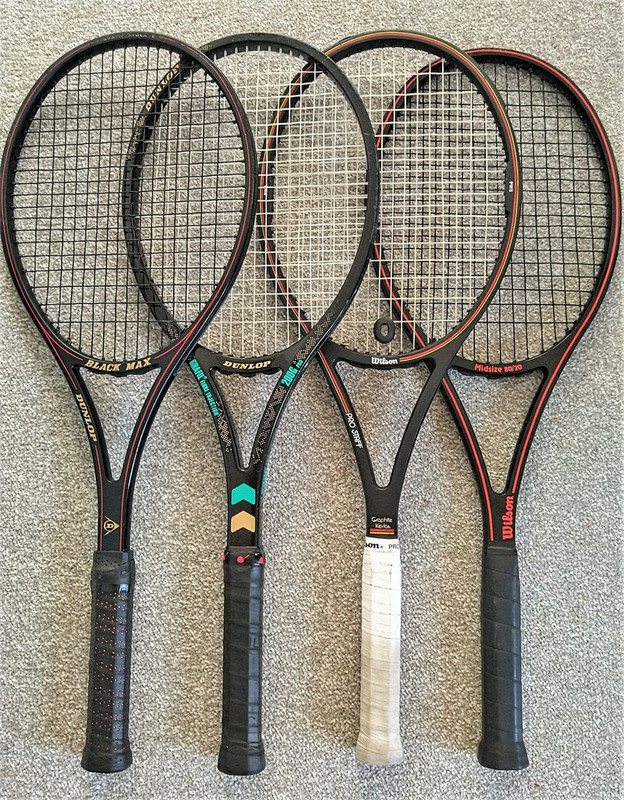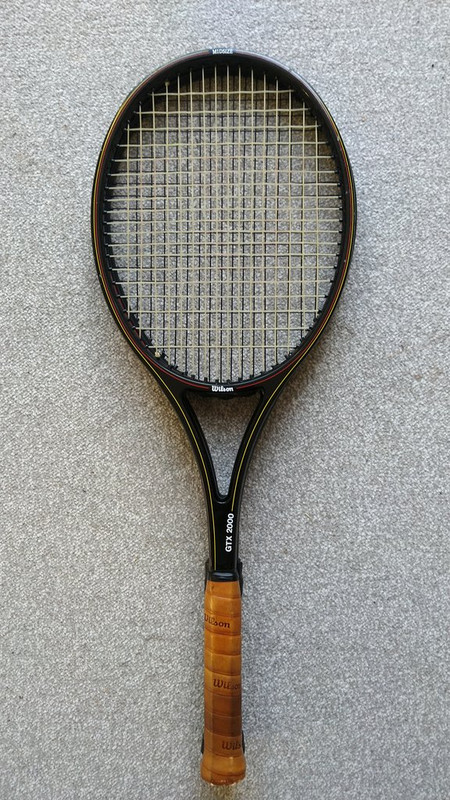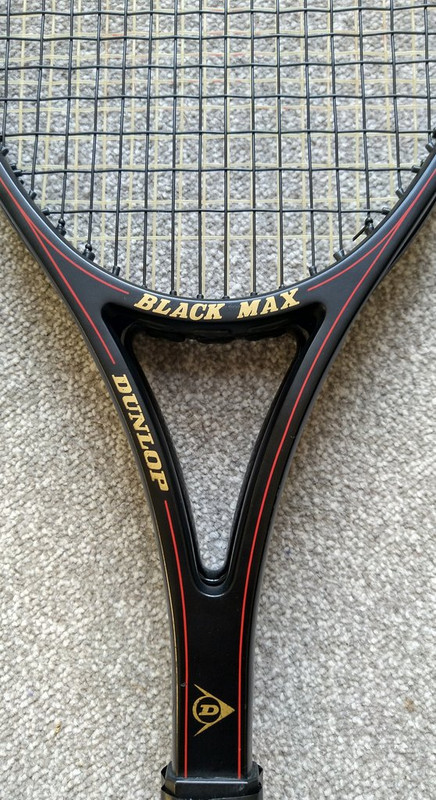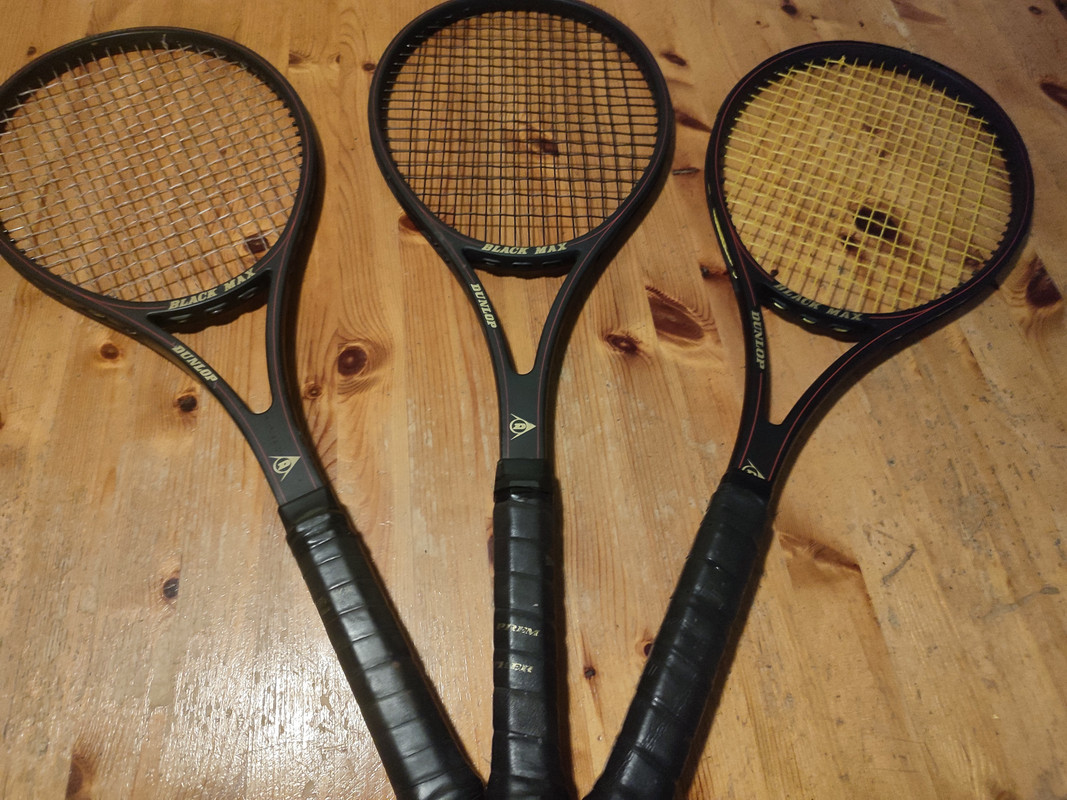Grafil Injection
Hall of Fame
[Although there are various BM threads already, I couldn't find any that the content was still live and the pictures still linked]
I have wanted a Black Max since I first saw the adverts in the early 80s, which made it look like a mean and classy stick. Although it came out in the late 70s, such adverts were produced for the original version ('Graphite/Glass' on hoop) as late as 1986, so it had a good run and it certainly was considered a high level offering, at least until the 200G came along.

{Black Max, MAX 200G Glossy, PS85 SV3, Wilson 80/20)
I believe the one I've finally picked up is a fairly early example because it says Midsize Metal on the cover, whereas, later versions say Graphite on the cover.
There is great similarity in the design with the later Wilson PS85: even though mine is a bit worn, the paintwork is simple and has a classy matt finish; the beam is actually 1mm thinner than the PS85 at 16mm (same as the PK Black Ace), giving an very solid feel in-hand. Even closer similarity is with the Wilson 80/20, but the moulds are definitely slightly different (BM is rounder). Dunlop (via Taiwan) used their 'Premium Calfskin Leather' grip, which is thicker than the leather used on the MAX 200G or MaxPly woods. It's a lovely piece or leather, but would be better as a belt than a grip. It's too thick and becomes shiny. Specs are right where you would imagine: L4 - 360g, 31.75cm (8pt) HL strung. I removed the leather grip as it was fraying, and to get it down to size 3 using a Dan Evans 2 overgrip treament. Hence, mine is now 352g, 32.25cm (6pt) HL, so still fairly manoeuvrable.
Hitting is very close in feel to various Taiwan 85s with 80/20 or 70/30 graphite/glass mix, so the flex should be in the mid to high 50s. Obviously, nowhere near the stiffness of a PS85, but there is also no flutter and the sweetspot still feels large like the Wilson 80/20 also does. Black Max is not a noodle! The 16x19 pattern has a 1.35cm2 average cell size, which is a tad tighter than a PS85 (1.4cm2), but still somewhat open.
The only issue I've found, which a Youtube reviewer also mentioned, is the grip shape is very square. Bevels 0 and 4 being too large, so I am tempted to sand a bit of PU from bevels 1, 3, 5 & 7. So far though, after one brief hit, I can see why this was popular in the early 80s and is still a fine hit today. Note that mine was L4; I don't know whether LM and M versions also existed.
What I was wondering was why it didn't cut through at the Pro level? Was it too 'new-fangled' to replace the woods, and then got overtaken by MAX 200G and PS85 etc? I suppose it also didn't have quite the control/feel of the woods either.
I have wanted a Black Max since I first saw the adverts in the early 80s, which made it look like a mean and classy stick. Although it came out in the late 70s, such adverts were produced for the original version ('Graphite/Glass' on hoop) as late as 1986, so it had a good run and it certainly was considered a high level offering, at least until the 200G came along.

{Black Max, MAX 200G Glossy, PS85 SV3, Wilson 80/20)
I believe the one I've finally picked up is a fairly early example because it says Midsize Metal on the cover, whereas, later versions say Graphite on the cover.
There is great similarity in the design with the later Wilson PS85: even though mine is a bit worn, the paintwork is simple and has a classy matt finish; the beam is actually 1mm thinner than the PS85 at 16mm (same as the PK Black Ace), giving an very solid feel in-hand. Even closer similarity is with the Wilson 80/20, but the moulds are definitely slightly different (BM is rounder). Dunlop (via Taiwan) used their 'Premium Calfskin Leather' grip, which is thicker than the leather used on the MAX 200G or MaxPly woods. It's a lovely piece or leather, but would be better as a belt than a grip. It's too thick and becomes shiny. Specs are right where you would imagine: L4 - 360g, 31.75cm (8pt) HL strung. I removed the leather grip as it was fraying, and to get it down to size 3 using a Dan Evans 2 overgrip treament. Hence, mine is now 352g, 32.25cm (6pt) HL, so still fairly manoeuvrable.
Hitting is very close in feel to various Taiwan 85s with 80/20 or 70/30 graphite/glass mix, so the flex should be in the mid to high 50s. Obviously, nowhere near the stiffness of a PS85, but there is also no flutter and the sweetspot still feels large like the Wilson 80/20 also does. Black Max is not a noodle! The 16x19 pattern has a 1.35cm2 average cell size, which is a tad tighter than a PS85 (1.4cm2), but still somewhat open.
The only issue I've found, which a Youtube reviewer also mentioned, is the grip shape is very square. Bevels 0 and 4 being too large, so I am tempted to sand a bit of PU from bevels 1, 3, 5 & 7. So far though, after one brief hit, I can see why this was popular in the early 80s and is still a fine hit today. Note that mine was L4; I don't know whether LM and M versions also existed.
What I was wondering was why it didn't cut through at the Pro level? Was it too 'new-fangled' to replace the woods, and then got overtaken by MAX 200G and PS85 etc? I suppose it also didn't have quite the control/feel of the woods either.
Last edited:







